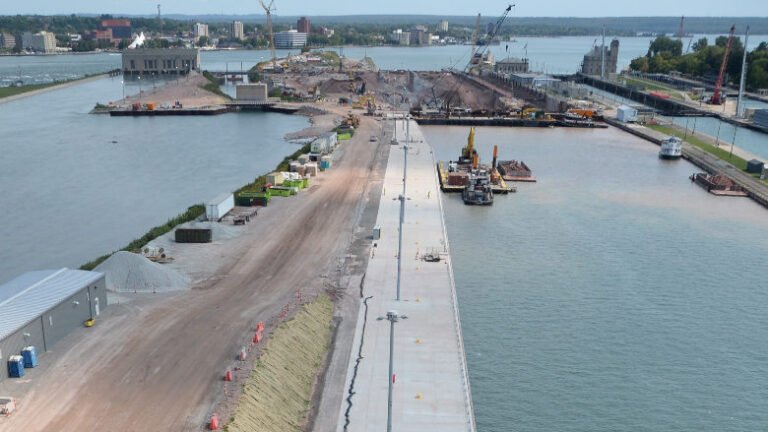
The US Army Corps of Engineers’ $3.2 billion New Lock on the Soo reached a milestone with substantial completion of Phase 2 work, officials announced Sept. 26. Work on the third and final phase is already underway.
Phase 2 saw the construction of the upstream approach walls. Contractor Kokosing-Alberici built, filled and capped 52 coffer cells and rehabilitated 4,800 linear feet of walls under a $117 million contract the Corps awarded in 2020. The new approach walls replace existing more than 100 years, according to project engineer Ryan. Berkompas. The new walls will allow boats to be moored along them.
“Minor electrical work is expected to be addressed through the end of October with the goal of financially closing the contract by the end of November,” Berkompas said in a statement.
The project is replacing two of the Soo closures in Sault Ste. Marie, Mich., with a larger one measuring 1,200 feet long, 110 feet wide and 32 feet deep to accommodate modern transport ships. Currently, only one of the Soo locks is large enough for 1,000-foot “Laker” vessels, so most cargo passing through the locks is confined to that single lock. Corps officials say the project is needed to help ensure the efficient flow of cargo between the Great Lakes and allow for needed rehabilitation work at this largest existing lock.
The two partners in the Phase 2 joint venture contractor are also part of a separate JV, Kokosing Alberici Traylor LLC, which is working on the larger Phase 3. The substantial completion of Phase 2 comes shortly after the Corps awarded a $222.7 million contract option for part of the work. The Corps awarded the $1.1 billion base contract in 2022 and has anticipated that $749.5 million in contract options will be awarded as funding becomes available. Officials said earlier this month that only three options remain for a combined value of $95.3 million.
Work on the schedule for the rest of this year includes construction of the pump pit substructure and lock chamber wall, according to the Corps.
“Phase 3 construction began in late 2022 and, given efficient financing and a favorable climate, is on track for completion in 2030,” Mollie Mahoney, the Corps’ senior project manager, said in a communicated

